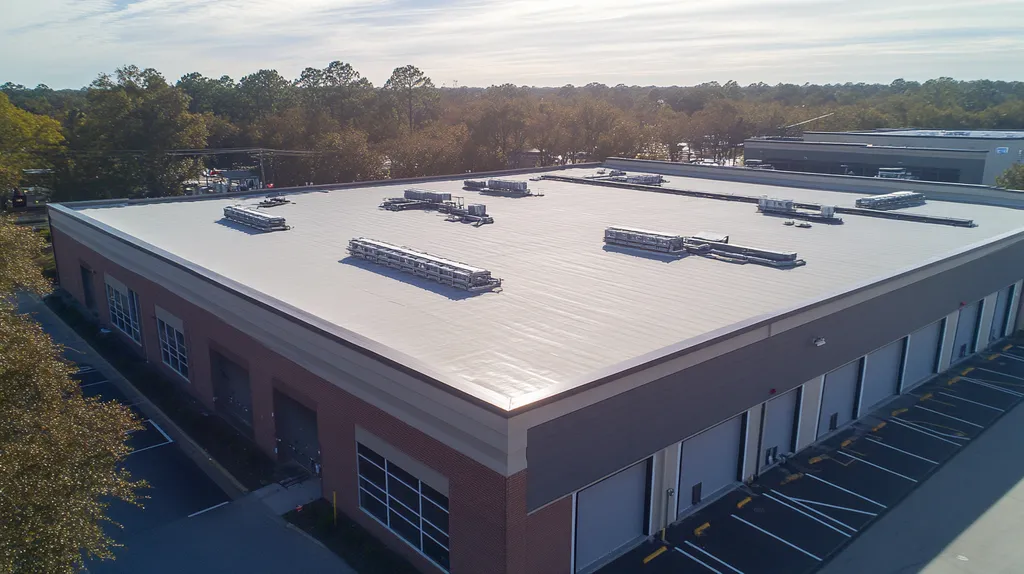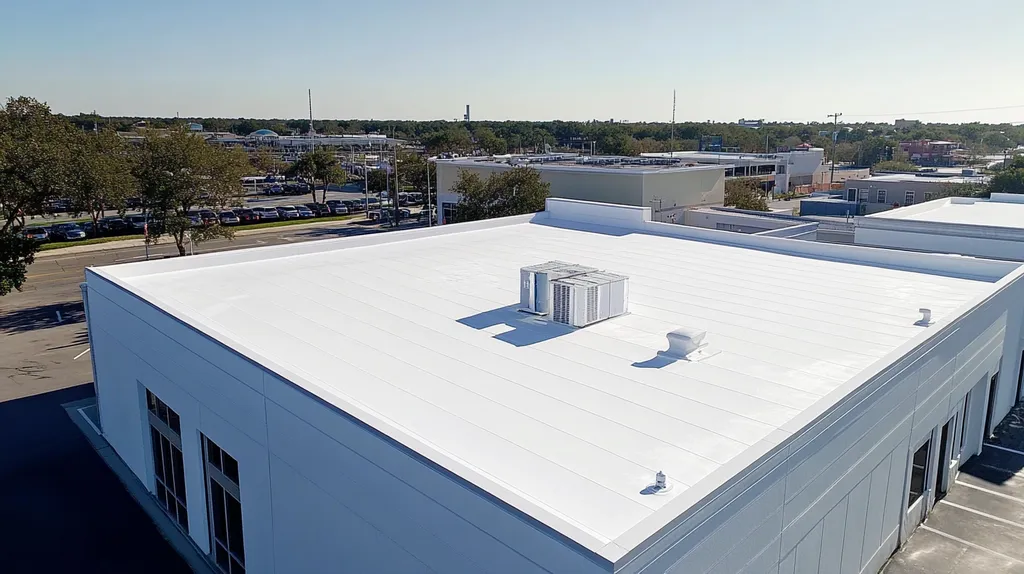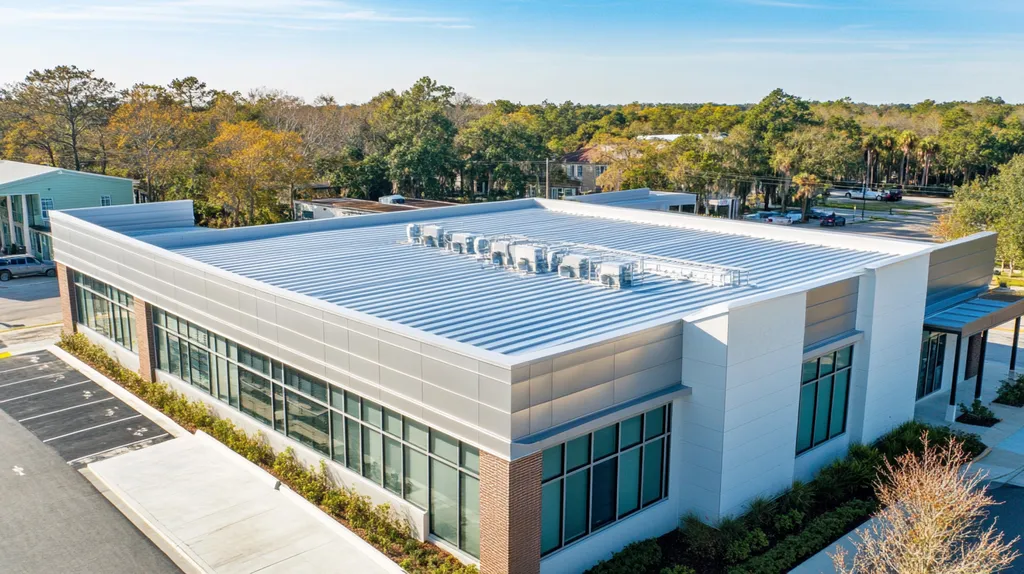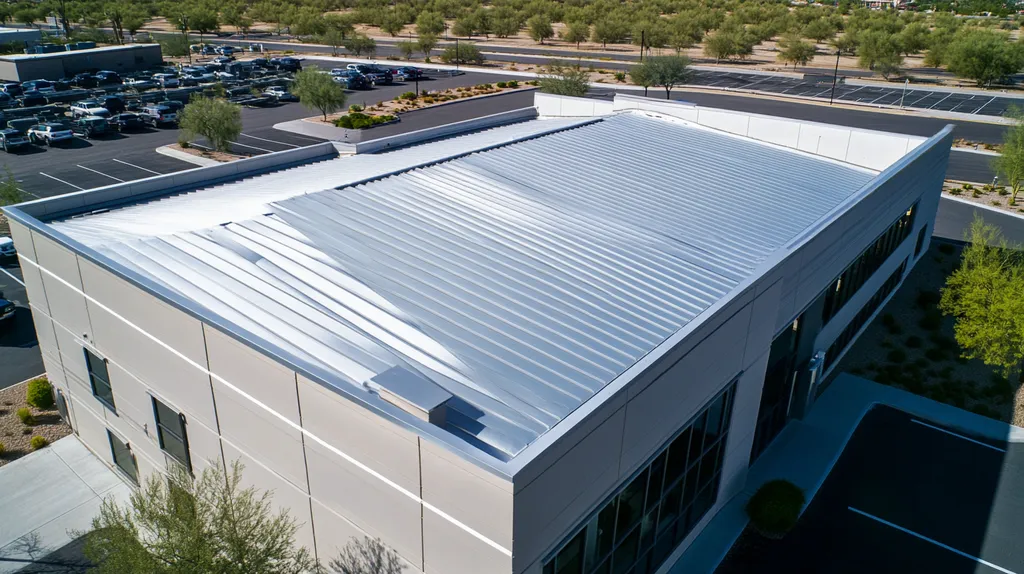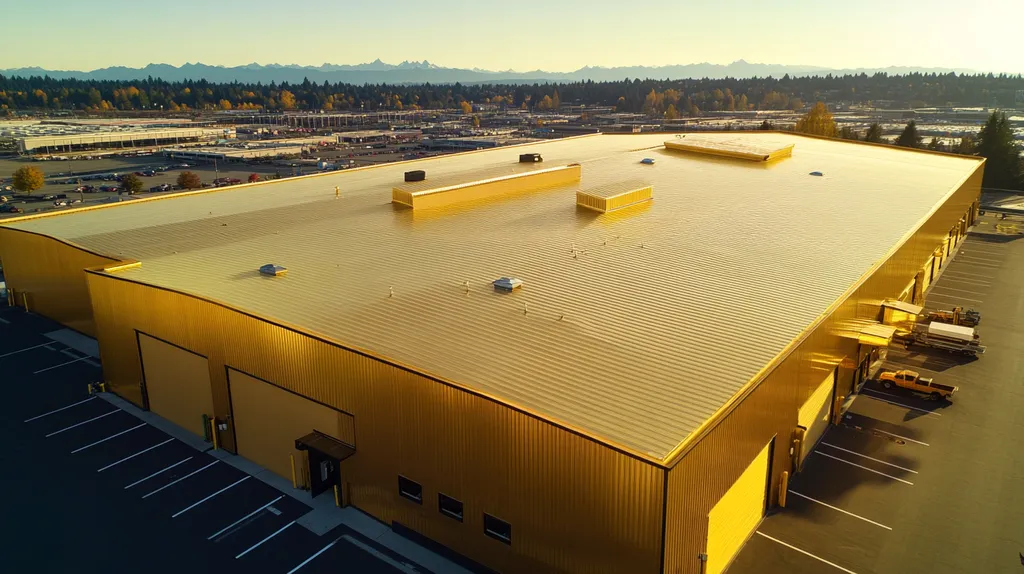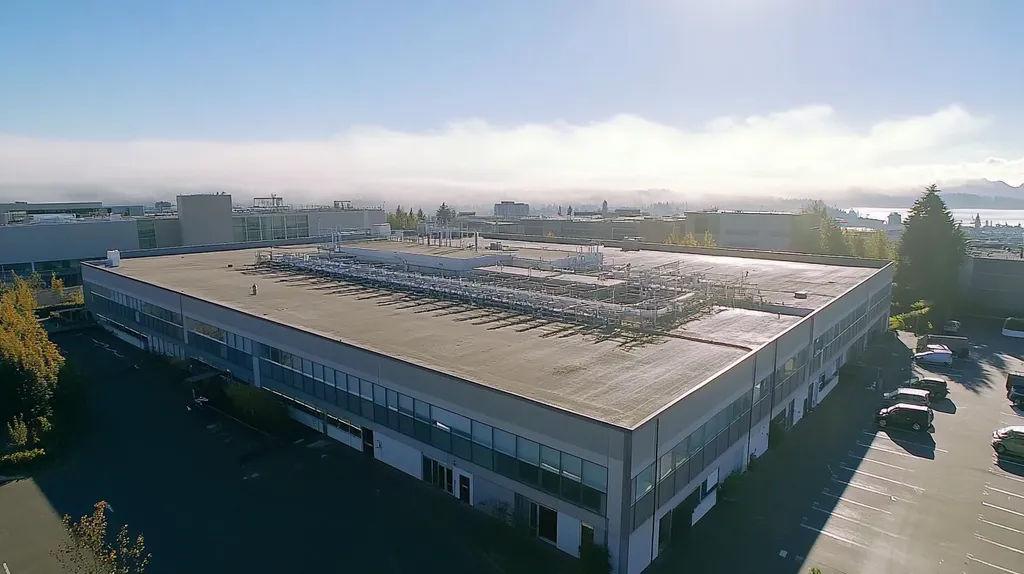Welcome to today’s Battle Royale featuring two roofing heavyweights: “Acrylic Roof Coatings” in the east corner versus “Polyurethane Roof Coatings” in the west!
Tonight’s showdown pits these contenders against each other across six punishing rounds designed to test every aspect of their performance for Commercial Roof Coating Application.
At stake? Millions in potential costs, decades of building protection, and the critical performance demands of modern commercial and industrial facilities.
Our professional judging panel will evaluate each round on technical merit, real-world performance, and value delivery. After all six rounds, we’ll declare our ultimate champion.
Ladies and gentlemen, facility managers and building owners… it’s time to rumble!
ROUND 1: INITIAL COSTS & INSTALLATION
In the high-stakes world of commercial roofing, timing is everything – and nothing impacts timing quite like weather. With coating projects ranging from $3 to $7 per square foot nationally, choosing the wrong coating system or application window can transform a routine project into a costly ordeal that impacts both budget and business operations.
Material Expenses
Material costs form the foundation of any roofing project’s budget. Acrylic roof coatings typically command $1.50 to $3.00 per square foot, making them an attractive option for cost-conscious property managers looking to maximize their maintenance budgets.
Polyurethane coatings demand a premium, usually $3.00 to $5.00 per square foot. While this higher price point reflects enhanced durability and weather resistance, it can strain initial project budgets.
The substantial price difference makes acrylic coatings the clear choice for properties operating under tight budget constraints, though savvy managers must weigh this against long-term performance needs.
Installation Complexity
Weather conditions dramatically impact installation success, particularly for water-based acrylic coatings. These coatings require precise temperature and humidity conditions, with contractors needing to carefully monitor weather forecasts to avoid wash-offs that can occur even days after application. (source: American WeatherStar)
Polyurethane coatings offer more flexibility in application conditions but demand specialized equipment and expertise. Their two-component mixing requirements and shorter working time add layers of complexity to the installation process.
Despite weather sensitivity, acrylic coatings generally require less specialized equipment and expertise, giving them an advantage in overall installation complexity.
Project Timeline
Time equals money in commercial roofing, and project duration directly impacts business operations. Acrylic coatings typically allow for rapid application, with most projects completed in 2-3 days under optimal conditions.
Polyurethane installations demand more time due to their complex application requirements. The mixing process, shorter working time, and multiple coat requirements can stretch projects to a week or longer.
While weather dependency can extend acrylic coating timelines, their generally faster application and simpler process gives them an edge in project duration.
ROUND 1 WINNER: Acrylic Roof Coatings
ROUND 2: DURABILITY & LIFESPAN
In the battle for rooftop supremacy, durability determines whether your coating choice becomes a hero or a costly headache. With commercial roof repairs averaging $8-15 per square foot, choosing the wrong coating system can transform a simple maintenance decision into a recurring nightmare of patches and repairs.
Weather Resistance
Mother Nature tests every roof coating with an unrelenting combination of UV rays, precipitation, and temperature swings. Understanding how different coatings handle these challenges is crucial for long-term performance.
Acrylic coatings excel at UV reflection and heat resistance, helping buildings stay cooler and reducing energy costs. However, they can become brittle over time and may crack under extreme temperature fluctuations.
Polyurethane coatings maintain their flexibility and strength even under harsh conditions. Their superior chemical resistance and ability to withstand temperature extremes make them particularly suited for challenging environments.
ADVANTAGE: Polyurethane
Water Resistance
Standing water is the silent destroyer of roof coatings, making water resistance a critical factor in coating selection. Even small amounts of ponding can lead to coating degradation if not properly addressed.
Acrylic coatings show vulnerability to standing water, potentially softening or deteriorating under prolonged exposure. This weakness requires careful attention to roof drainage and regular maintenance to prevent problems.
Polyurethane coatings demonstrate exceptional resistance to ponding water, maintaining their integrity even under extended exposure. Their molecular structure creates a nearly impermeable barrier against moisture infiltration.
ADVANTAGE: Polyurethane
Longevity Expectations
The true measure of a coating’s value lies in its lifespan. While initial costs matter, the frequency of recoating dramatically impacts long-term facility budgets.
Acrylic coatings typically provide 7-10 years of service life when properly maintained. Their performance can be extended through regular maintenance and periodic recoating.
Polyurethane coatings routinely achieve 15-20 years of service life, often with minimal maintenance requirements. This extended lifespan often justifies their higher initial investment.
ADVANTAGE: Polyurethane
ROUND 2 WINNER: Polyurethane Roof Coatings
ROUND 3: PERFORMANCE FACTORS
When Mother Nature throws her worst at commercial roofs, coating performance becomes the difference between protection and catastrophe. With weather-related roof damage causing billions in annual losses, understanding how coatings respond to environmental stresses isn’t just smart business – it’s essential risk management.
Weather Resistance
In the battle against environmental forces, not all coatings are created equal. Heat, cold, rain, and UV radiation constantly test the limits of roof coating integrity, making weather resistance a crucial performance indicator.
Acrylic coatings shine brightest in UV protection, creating a highly reflective shield that helps regulate building temperatures. However, their molecular structure becomes increasingly brittle in cold temperatures, potentially compromising their protective capabilities during freeze-thaw cycles.
Polyurethane coatings maintain exceptional flexibility across extreme temperature ranges, from scorching heat to bitter cold. Their superior chemical resistance and structural stability provide consistent protection regardless of weather conditions.
ADVANTAGE: Polyurethane
Application Conditions
Success in coating application hinges on weather conditions during installation. Even minor environmental variations can impact adhesion, curing times, and long-term performance.
Acrylic coatings offer remarkable application flexibility, performing well in temperatures as low as 50°F and tolerating higher humidity levels. This versatility extends the viable installation window and reduces weather-related project delays.
Polyurethane coatings demand more precise conditions, requiring strict temperature and humidity control for proper curing. These stringent requirements can narrow the application window and potentially extend project timelines.
ADVANTAGE: Acrylic
Durability Against Elements
Long-term performance under harsh conditions separates exceptional coatings from adequate ones. The ability to maintain integrity despite constant environmental assault directly impacts maintenance costs and replacement cycles.
Acrylic coatings face challenges with prolonged water exposure, potentially softening or developing adhesion issues under ponding conditions. Their moderate impact resistance can leave them vulnerable to hail damage and foot traffic.
Polyurethane coatings excel in moisture resistance and maintain superior tensile strength over time. Their robust composition withstands impacts, ponding water, and chemical exposure while retaining flexibility and adhesion.
ADVANTAGE: Polyurethane
ROUND 3 WINNER: Polyurethane Roof Coatings
ROUND 4: MAINTENANCE REQUIREMENTS
In the high-stakes world of commercial roofing, maintenance missteps can transform minor issues into major catastrophes. With repair costs averaging $20-30 per square foot for emergency fixes, choosing a coating with manageable maintenance requirements becomes crucial for long-term facility budgets.
Poor maintenance practices don’t just threaten roof integrity – they can cascade into operational disruptions, tenant complaints, and unexpected capital expenditures that blindside even well-prepared facility managers.
Inspection Requirements
Regular inspections form the foundation of effective roof maintenance, with timing and scope varying dramatically between coating types. The frequency and complexity of these inspections directly impact facility maintenance budgets and staff resources.
Acrylic coatings demand quarterly visual inspections and annual detailed assessments. Their simpler composition makes damage easier to spot, allowing maintenance teams to identify potential issues before they become critical failures.
Polyurethane coatings require more specialized inspection protocols, often needing semi-annual detailed assessments. Their complex chemical structure demands trained professionals to properly evaluate coating integrity.
ADVANTAGE: Acrylic
Cleaning Protocols
Maintaining coating effectiveness requires regular cleaning to prevent debris accumulation and surface degradation. The complexity and frequency of cleaning directly impacts maintenance costs and roof longevity.
Acrylic coatings respond well to simple cleaning methods using standard commercial cleaning solutions. Their smooth surface naturally resists dirt accumulation, making maintenance less labor-intensive.
Polyurethane coatings often require specialized cleaning agents and techniques to maintain their protective properties. Their textured surface can trap debris, necessitating more frequent and thorough cleaning sessions.
ADVANTAGE: Acrylic
Repair Procedures
Even the best-maintained roofs eventually need repairs. The ease and cost of these repairs significantly impact long-term ownership costs.
Acrylic coatings offer straightforward repair procedures that facility maintenance teams can often handle internally. Their water-based composition allows for simple patch applications and touch-ups without specialized equipment.
Polyurethane repairs demand more technical expertise and equipment, often requiring professional contractors. Their chemical composition makes patches more challenging to blend seamlessly with existing coating.
ADVANTAGE: Acrylic
ROUND 4 WINNER: Acrylic Roof Coatings
ROUND 5: SUSTAINABILITY CREDENTIALS
As environmental regulations tighten and energy costs soar, sustainability has become a make-or-break factor in commercial roofing decisions. With buildings accounting for nearly 40% of global energy consumption, choosing the wrong roof coating can lock facility managers into decades of excessive carbon footprints and operational costs.
Modern sustainability standards demand more than just “green” marketing claims – they require documented performance across the entire product lifecycle, from manufacturing through disposal. Understanding these credentials has become essential for protecting both environmental and financial interests.
Life Cycle Analysis
Life cycle assessment evaluates environmental impacts from raw material extraction through end-of-life disposal. This comprehensive view helps facility managers understand the true environmental cost of their coating choices.
Acrylic coatings demonstrate superior environmental performance during manufacturing and application. Their water-based formulation produces minimal volatile organic compounds (VOCs) and requires no hazardous solvents during installation.
Polyurethane coatings face challenges in this category due to their chemical composition. Their production process generates higher emissions, and application requires careful handling of potentially hazardous materials.
ADVANTAGE: Acrylic
Energy Efficiency
Cool roof performance has become a critical metric as energy costs continue rising. The right coating choice can significantly impact building temperature regulation and HVAC load requirements.
Acrylic coatings excel in solar reflectance, often achieving reflectivity ratings above 85%. This performance translates directly into reduced cooling costs and lower peak energy demand during summer months.
Polyurethane coatings typically achieve lower reflectivity ratings, though some specialized formulations can match acrylic performance. Their superior insulation properties help offset this limitation by reducing heat transfer year-round.
ADVANTAGE: Acrylic
Material Sustainability
Raw material sourcing and disposal options significantly impact a coating’s environmental footprint. Responsible manufacturers now emphasize renewable content and end-of-life recyclability.
Acrylic coatings increasingly incorporate recycled content and bio-based materials. Their simple chemical structure facilitates recycling at end-of-life, though market infrastructure remains limited.
Polyurethane coatings face recycling challenges due to their complex chemical composition. While some manufacturers offer take-back programs, most polyurethane coatings eventually contribute to landfill waste.
ADVANTAGE: Acrylic
ROUND 5 WINNER: Acrylic Roof Coatings
ROUND 6: SPECIALIZED APPLICATIONS
When specialized roofing applications meet extreme weather conditions, the margin for error vanishes. With commercial roof failures costing businesses millions annually in equipment damage and operational disruptions, choosing the wrong coating for challenging environments can transform routine maintenance into catastrophic expense.
Environmental stressors like chemical exposure, extreme temperatures, and constant UV bombardment push coating materials to their absolute limits. Success or failure often hinges on selecting materials precisely matched to these demanding conditions.
Chemical Resistance Requirements
Industrial environments present unique challenges where exposure to harsh chemicals, oils, and environmental pollutants can rapidly degrade standard coating systems. These specialized applications demand materials capable of maintaining their protective properties despite constant chemical assault.
Acrylic coatings show moderate chemical resistance but can break down when exposed to industrial solvents or acidic compounds. Their water-based chemistry makes them particularly vulnerable to chemical penetration and degradation over time.
Polyurethane coatings excel in chemical resistance, creating an nearly impermeable barrier against most industrial contaminants. Their cross-linked molecular structure maintains integrity even under sustained chemical exposure.
ADVANTAGE: Polyurethane
Extreme Temperature Performance
From freezing cold storage facilities to sun-baked processing plants, specialized applications often involve temperature extremes that push coating materials to their limits. The wrong choice can lead to brittleness, cracking, or complete coating failure.
Acrylic coatings become increasingly brittle in cold environments and may soften excessively under extreme heat. This temperature sensitivity can compromise their protective capabilities precisely when they’re needed most.
Polyurethane coatings maintain their physical properties across a much wider temperature range. Their superior flexibility and thermal stability make them ideal for environments with dramatic temperature swings.
ADVANTAGE: Polyurethane
Impact and Abrasion Requirements
High-traffic areas and equipment-heavy zones demand coatings capable of withstanding constant physical abuse. Impact resistance and abrasion protection become critical factors in these specialized applications.
Acrylic coatings provide moderate impact resistance but can wear quickly under heavy foot traffic or equipment movement. Their softer composition makes them vulnerable to scratching and scuffing in high-wear areas.
Polyurethane coatings deliver superior impact resistance and exceptional wear characteristics. Their durable composition resists punctures, tears, and abrasion while maintaining waterproof integrity.
ADVANTAGE: Polyurethane
ROUND 6 WINNER: Polyurethane Roof Coatings
AND THE WINNER IS…
After six grueling rounds of technical evaluation, we have our verdict… With a score of 4 rounds to 2, POLYURETHANE ROOF COATINGS claims the championship belt!
Polyurethane dominated the durability, performance, and specialized application categories, showcasing superior chemical resistance, flexibility across extreme temperatures, and unmatched longevity. Its ability to withstand ponding water while maintaining structural integrity proved decisive in securing this victory.
But don’t count acrylic coatings out! Their impressive showing in maintenance, sustainability, and cost-effectiveness makes them a smart choice for buildings in moderate climates with regular maintenance schedules and tight initial budgets.
Remember, folks – every building tells its own story. Local weather patterns, substrate conditions, and facility-specific requirements can dramatically impact coating performance. While this analysis provides general guidance, it can’t account for all variables. Property owners should always consult qualified roofing professionals who can evaluate their specific situation before making a final decision.
In the high-stakes world of commercial roofing, there’s no substitute for informed decision-making. Because when that next storm hits or that summer sun beats down, you want to know you’ve got the right contender in your corner.
FREQUENTLY ASKED QUESTIONS
Q. What are the initial costs of commercial roof coatings?
A. When considering commercial roof coatings, costs vary significantly. Acrylic coatings range from $1.50 to $3.00 per square foot, making them budget-friendly. Meanwhile, polyurethane coatings tend to be pricier, costing between $3.00 and $5.00 per square foot, reflecting their enhanced durability. Choosing the right coating can save you dollars upfront, but think long-term for value.
Q. How durable are different industrial roof coatings?
A. Durability varies between coatings. Acrylic coatings usually last 7-10 years, while polyurethane boasts an impressive 15-20 years of service life. Both types have weather resistance, but polyurethane stands out for extreme conditions. When it comes to longevity, a little extra investment can yield substantial savings down the line.
Q. How do weather conditions impact commercial roof coatings?
A. Weather can make or break a coating installation. Acrylic coatings are sensitive to humidity and temperature, while polyurethane requires strict environmental controls during application. Understanding these conditions is crucial for achieving strong adhesion and effective performance. Selection and timing of application can save both time and money!
Q. What maintenance do commercial roof coatings require?
A. Maintenance requirements differ between coatings. Acrylic coatings need more frequent inspections, with quarterly checks to catch issues early. In contrast, polyurethane coatings mandate semi-annual assessments and specialized cleaning techniques. Proper maintenance helps avoid costly repairs and extends the life of your roof, proving that vigilance pays off.
Q. Are commercial roof coatings environmentally sustainable?
A. Sustainability is more important than ever. Acrylic coatings typically have lower emissions during production, making them a greener choice. Meanwhile, polyurethane coatings can have a higher environmental impact due to harmful solvents and chemicals. Opting for environmentally friendly products can reduce long-term operational costs and align with corporate responsibility goals.
Q. Which coating is best for specialized commercial roofing applications?
A. Specialized applications often require exceptional materials. Polyurethane coatings excel in environments with harsh chemicals or extreme temperatures due to their superior flexibility and resistance. Acrylic coatings, while versatile, may struggle under intense conditions. It’s essential to select a coating that matches the specific challenges your roof will face.
Q. What are the consequences of improper roof coating application?
A. Improper application can lead to premature coating failure, resulting in costly repairs and operational disruptions. Poor adhesion, inadequate curing, and environmental oversights can all contribute to significant headache down the line. To safeguard your investment, it’s vital to follow manufacturer guidelines and monitor conditions throughout the application process.

